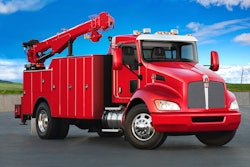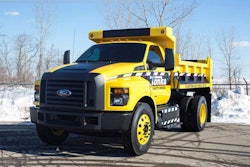
The Federal Bridge Law was established in 1975 by Congress. It is codified in 23 CFR §658.17. For those that did not enjoy algebra in high school, the law might as well be a quadratic equation. On the other hand, the quadratic formula always finds a solution. (Maybe we should have paid more attention.) The bridge law is very important for those in construction to understand, especially those who deal with heavy equipment and the moving of heavy equipment.
The bridge law was established to set a ratio of length to width for when a heavy vehicle crosses a bridge—hence the name. It doesn’t take a mathematician to realize that weight over a small area will create more stress than the same weight placed over a greater area.
Since truck wheels provide a relatively small area of contact with the surface, an effective way to increase surface area is to add extra wheels. In the bridge law and formula, extra wheel surface is accomplished by adding axles. The more axles in any length, the more gross weight is allowed in the span.
The Formula
Let’s take a look at the formula:

Eww, that’s pretty ugly. What does it all mean?
Well, just like any formula, the letters stand for variables. There is only one unknown variable in the formula, which is represented by “W.” The “W” stands for “weight,” or the allowed gross weight on the axles that are being considered. So what do the “L” and “N” stand for? While variables, they are known variables. “L” stands for “length” in feet between the outermost axles under consideration, and the “N” stands for the number of axles.
There are charts that fill in all of the variables and provide the result for “W,” but they can be as confusing to view as the formula itself.
So even if it is understood, how does it apply to heavy construction equipment or the moving of heavy equipment? Well, let’s take a look at moving a piece of equipment on a lowboy. The lowboy could have a tandem axle on the drive axles of the power unit or on the trailer. It may help to throw in some numbers. Let’s say we want to determine the allowed gross weight on 2 axles over 5 feet:
L = 5; and
N = 2
Substituting the known numbers for the variables, at first it doesn’t make it look all that much easier:

But it simplifies to which in turn simplifies to:

and that becomes:
W = 500 (10+24+36) and that becomes W = 500 (70)
So, W = 35,000 pounds (allowed gross weight on the 2 axles). If not a number divisible by 500, the result needs to be rounded down to the nearest allowed 500 pounds. Since our result is divisible by 500, the result is 35,000 pounds. Or is it?
The bridge rule applies to any, and all, possible axle groups. A single axle is allowed 20,000 pounds. Two axles 4 feet to 8 feet apart are preset at 34,000 pounds. This allows for varying manufacturers’ configurations to have the same standard tandem weight allowance. This standard applies to most tractors’ drive axles and standard semitrailer “tandems,” including our example, so the two axles are only allowed 34,000 pounds
Sorry that you asked? The Federal Highway Administration has an automated calculator for the bridge formula here. The bridge allowance is “maxed” out once the axle or total gross is reached, unless allowed additional weight by permit. When overweight permits are issued, many states still expect the axles “to scale out” to the bridge formula.
On-Demand Axles
Need to haul extra weight, but not necessarily overweight loads? This is where lift axles can help. If there was an engaged (down) axle in front of (or behind) our tandem group on the drive axles of the power, or on the trailer, how would that change the allowed gross on the axles?
In the example, the number of axles (“N”) increases to 3, and the distance (“L”), (for the sake of example) increases to 13 feet. Using the same formula, the gross weight allowed on the axle group increases to 45,500 pounds, allowing nearly 34% more payload on the axle group with nearly the same vehicle configuration.
Lift axles can be on the truck-tractor, straight truck, or on a trailing unit. Keep in mind that some states limit the amount of weight on a “tridem” axle group as well as on “tandems,” but the tridem allowance will always be significantly higher than what is allowed on a tandem group.
Other Considerations
The Canadian provinces currently frown on lift axle usage, with one province requiring them to be chained in the up position. They are allowed in all 50 states, but like state regulations and statutes, the rules can vary from state to state. Alaska, for instance, will not allow lift axles to be considered in the gross weight calculation.
When lift axles are part of a tandem group, as described above, the group is only permitted the full allowed weight when the lift axle is fully engaged. Many states require that the control for the lift axle be out of the cab so the driver cannot “cheat” by only having the axle partially engaged or only when “big brother” may be watching.
Some states allow the axle to be lifted when negotiating a corner, but the axle must be lowered subsequently in short order. When an enforcement officer has witnessed operation in the raised position, other than for cornering, the driver will not be given the opportunity to lower the axle before scaling. As in our example above, the allowed weight difference can be significant with severe fines as a consequence.
In addition to the added gross allowed on axle group, lift axles are reported to reduce rolling resistance improving fuel economy while reducing maintenance expenses on the axle not used 100% of the time.
If your operation is often close to being overweight (or is overweight) on axle groups or the total gross weight allowed for the vehicle’s wheelbase, lift axles can be a viable alternative. For these reasons, lift axles are increasingly available on dump trucks, concrete mixers, powers and trailers to maximize payload for the wheelbase and increase productivity.












